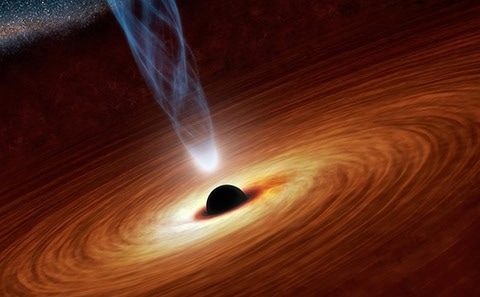Black holes could exist in perfectly balanced pairs that are kept in equilibrium by a cosmic force, resembling a single black hole, according to a study from the Universities of Southampton, Cambridge, and Barcelona.

Artist concept of supermassive black hole. Image Credit: NASA/JPL-Caltech
Massive celestial phenomena known as black holes have a gravitational pull so powerful that nothing can escape from them, not even light. They have an incredible density - the mass of the Earth could fit inside a black hole the size of a pea.
Typically, conventional ideas regarding black holes describe how static or spinning black holes can exist independently, separated in space, based on Einstein’s General Relativity theory. Gravity would ultimately draw black holes in pairs together and cause them to collide.
This is accurate if one believes that the universe remains still. However, what about one that moves all the time? Could black hole pairings coexist peacefully in an ever-expanding universe—possibly even acting as one?
The standard model of cosmology assumes that the Big Bang brought the Universe into existence and that, approximately 9.8 billion years ago, it became dominated by a mysterious force, coined ‘dark energy’, which accelerates the Universe at a constant rate.
Oscar Dias, Professor, University of Southampton
This enigmatic force is known to scientists as a “cosmological constant.” Black holes are submerged in a cosmic accelerated backdrop in a universe described by Einstein’s theory with a cosmological constant. This shifts the theoretical objectives of the coexistence and interaction of black holes.
This current study team used sophisticated computational techniques to demonstrate that two static (non-spinning) black holes can coexist in equilibrium, with the expansion linked to a cosmological constant offsetting the gravitational pull of one another.
The black holes are trapped at a constant distance from one another even as the universe accelerates and expands. Despite the force of expansion trying to separate them, the gravitational attraction keeps them together.
Dias added, “Viewed from a distance, a pair of black holes whose attraction is offset by cosmic expansion would look like a single black hole. It might be hard to detect whether it is a single black hole or a pair of them.”
Professor Jorge Santos of the University of Cambridge added, “Our theory is proven for a pair of static black holes, but we believe it could be applied to spinning ones too. Also, it seems plausible that our solution could hold true for three or even four black holes, opening up a whole range of possibilities.”
Professor Gary Gibbons from Cambridge University, Professor Oscar Dias from Southampton University, Professor Jorge Santos from Cambridge University, and Dr. Benson Way from Barcelona University carried out this investigation. The journal Physical Review Letters published the study "Static Black Binaries in de Sitter Space," which is reviewed as a Viewpoint article.
Journal Reference
Dias, O. J. C., et al. (2023) Static Black Binaries in de Sitter Space. Physical Review Letters. doi:10.1103/PhysRevLett.131.131401